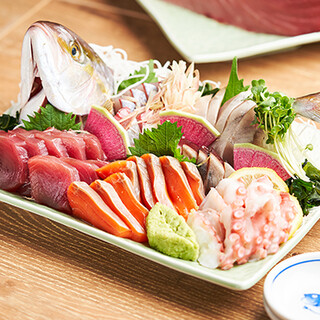
酒と魚 海神-UMIGAMI-
Sake to Sakana Umigami-UMIGAMI-
3.30
Jinbocho, Suidobashi
「Izakaya (Tavern)」
4,000-4,999円
1,000-1,999円
Opening hours: Monday, Tuesday, Wednesday, Thursday, Saturday
12:00 - 00:30 L.O. Food 23:30, Drinks 00:00
Fri.
12:00 - 01:00 L.O. 00:30
Sunday & Holidays
12:00 - 23:00 L.O. 22:30
Rest time: Lunch LO14:30(We accept drinks, individual orders, and banquets during lunch hours as well) *Reservations for 8 or more persons outside business hours are available upon request. No regular holidays
東京都千代田区神田神保町1-10-1 AL BUILDING
Photos
(20)
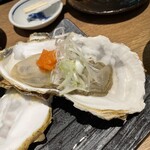
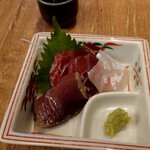
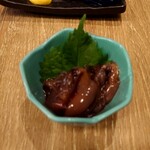
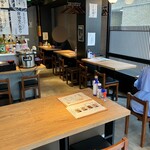


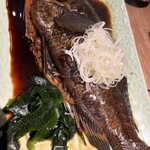
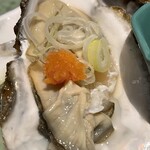
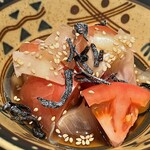
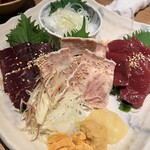

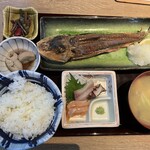

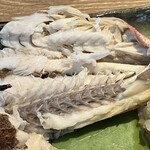


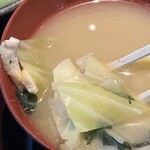

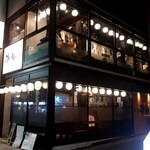
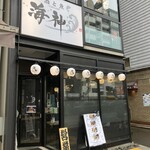
Details
Reservation Info
Reservations are possible. No-shows will be charged a cancellation fee. Cancellation fee may be charged on busy days. We will inform you of busy days in advance by phone or e-mail.
Children
Sub-supplies available (available for elementary school students)
Payment Method
Credit cards accepted
(VISA, Master, JCB, AMEX, Diners)
Electronic money accepted (transportation system electronic money (Suica, etc.), Rakuten Edy, nanaco, WAON, QUICPay)
QR code payment available
(PayPay)
Number of Seats
58 seats
(table seats, counter seats)
Private Dining Rooms
None
Smoking and Non-Smoking
Smoking: 34 smoking seats (paper cigarettes allowed), 24 non-smoking seats The law concerning measures against passive smoking (revised Health Promotion Law) has been enforced since April 1, 2020.
Parking
None
Coin-operated parking available nearby.
Facilities
Stylish space, calm space, large seats, counter seats available, sofa seats available, sports viewing available, projector available, power supply available, free Wi-Fi available
Drink
Sake available, shochu available, wine available, focus on sake
Dishes
Stick to vegetable dishes, fish dishes.
Comments
(21)
yukari7357
3.50
This restaurant lets you choose between sashimi or tempura for your starter, and they can be different for each person. It's such a treat to have delicious marinated mackerel as an appetizer! The dashimaki (Japanese omelet) and fried oysters were also tasty—such a surprise that both were only 480 yen. They’re open until just before the last train, except on Sundays and holidays, and it's very convenient as it's just a short walk from the A5 exit of Jimbocho Station, making it a great spot to enjoy some seafood and a drink on your way home.
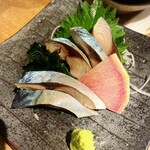
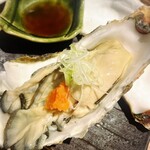

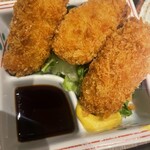
yukidate
4.00
On a Saturday afternoon, I went out for lunch during a local publisher's event. When you think of Jimbocho, you usually associate it with many famous curry shops, so I was surprised to find a fish restaurant with a relatively older clientele... or so I thought. However, when I entered the restaurant, I was greeted by a surprisingly young crowd, including foreigners who skillfully used chopsticks. The lunch set menu looked delicious, making it difficult to choose. I considered the grilled fish set of the day, which featured a large horse mackerel, but I was concerned I might not be able to finish it. Instead, I opted for the simmered fish set (red fish). The fresh red fish was enhanced by a simple simmering sauce made of slightly sweet soy sauce and sugar, bringing out its rich flavors! The fish was succulent and incredibly tasty! For sashimi, I had bonito, tuna, and yellowtail, which I enjoyed with a sweet Kyushu-style sashimi soy sauce available on the table. The miso soup was made with clams, and the simmered dish featured scallop entrails with blanched greens. Everything was truly delicious!
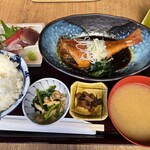
gunners9621
3.00
[Positive Points] - Atmosphere: I visited with a friend, and although the restaurant has two floors, the space is somewhat narrow. - Taste: The tempura and buri shabu (yellowtail hot pot) were delicious! Other dishes like sweet potato butter, potato salad, and fried chicken were also outstanding. (The fried chicken comes with three large pieces per order.) - Ordering: The mobile ordering system made it easy to place our order. [Other] - Waiting Time: I visited on a Friday night at 8 PM, and it seems difficult to enter without a reservation. The restaurant is near Jimbocho Station and faces a major road, making it a popular spot.

sasakinoko
3.00
This was my second visit. It’s a restaurant that focuses on fish. The dashimaki tamago (Japanese rolled omelette) in the photo was exquisite. They also had a wide variety of sake, which was impressive. The sashimi was delicious as well. I went without a reservation and was able to be seated quickly, which was great. I highly recommend it.
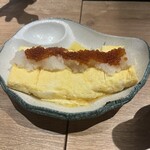
ミンピー0204
3.30
I visited the restaurant a little late at 9 PM. Despite the low prices, I thought the taste was good. Everything was delicious. I appreciated the creative dishes they offered. However, I was a bit concerned about the long wait for the grilled fish. Additionally, it felt like a place aimed at younger customers, so it was quite noisy. The raw oysters, in particular, were very delicious.
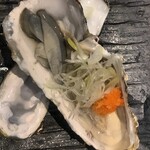
いけっち0728
3.20
The fish is delicious, and the course with all-you-can-drink is quite reasonable at 4,500 yen. There are also private rooms available. You can smoke here as well. While I feel that the extravagance of the course has slightly declined since the restaurant opened, the à la carte options remain just as tasty.
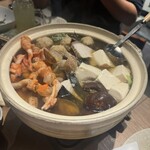
yuppeco
3.30
I’ve been curious about this izakaya near the station every time I passed by. True to its name, they had a lot of seafood options on the menu. It’s rare these days to find a place that allows smoking, so keep that in mind if you’re not a fan of tobacco. It was interesting that you could choose between sashimi or tempura for the appetizers. I was also impressed by how courteous the staff were.
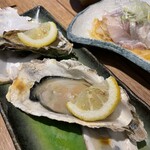

ハッピネス
2.80
It seems that lunch is only available on weekends. I had grilled buri kama (jaw of yellowtail), which was large and very satisfying. It came with sashimi and simmered fish. Unfortunately, the simmered fish wasn't very tasty. The staff were very friendly and helpful.
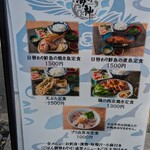
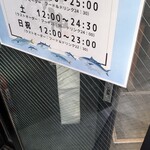
シモ007
3.50
Since I often go to places that serve grilled meats, I decided to try a seafood izakaya for a change. The restaurant was quite cramped and crowded, likely due to its location in a busy area. It was interesting that the appetizer could be chosen between sashimi or tempura for each person, and I opted for the sashimi.
I then placed my orders through a QR code for the following:
- Fresh oysters
- Seafood pepporon stir-fry
- Rare tuna cutlet
The tuna cutlet, which is one of their signature dishes, didn’t look particularly impressive, but the rare texture was quite appealing and delicious. The seafood pepporon stir-fry also didn’t look like much, but it made for a great snack. Although the restroom was inconveniently located outside and there was only one, this place was perfect for enjoying a light drink with seafood.
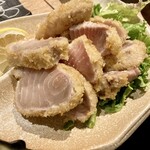

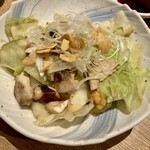
aogourmet
3.70
In Jimbocho, there's a bar that's open until close to the last train on Saturdays and also open on Sundays. What's unique is that the starter (otoshi) is either tempura or sashimi. The tempura is fluffy and crispy, really authentic. They also have a campaign where you can enjoy oysters with ponzu sauce at a discounted price. Additionally, the rolled omelette and other snacks were served quickly and were delicious. There’s a wide variety of drinks available, so whether you're a beer lover or a sake enthusiast, everyone can find something they like.
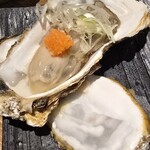
k.s-k947
3.20
On Saturday, I was grateful that this restaurant was open when many nearby shops weren't! It was an izakaya with incredibly delicious oysters and fried chicken! The beer was also very tasty, so I would like to visit again when I'm nearby! Next time, I want to try some sake and shochu as well!

無芸小食
3.50
Along 靖国通り, near the Jimbocho intersection, the 24-hour izakaya "Haneage" has been transformed into "Sake and Fish Umigami," which opened in November 2023. This restaurant is a sister store to "Masuya," "Kushinbo," and "Nikumotsuya Shinbo." Detailed information about the company, SK Corporation, including its history, can be found on its website. Originally starting with four franchise locations from Chimney Group, three quickly closed down, while the remaining store led by the current president, Tsutomu Hiraoka, achieved a turnaround and is now back to a four-store operation.
The restaurant has two floors: the first floor features four counter seats and eight four-person tables. On this visit, I noticed that two young staff members were efficiently managing the place. The appetizer (600 yen) can be chosen between sashimi or tempura, and I opted for the sashimi. It came with a three-piece selection of tuna, bonito, and sea bream. The sake selection includes ten standard types and ten seasonal offerings, totaling twenty varieties. I started with the standard "Gokai Yamada Nishiki Junmai Karakuchi" (580 yen) in a one-cup serving.
To accompany the sake, I ordered "Hotaruika Okizuke" (480 yen) and "Nasu Ipponzuke" (380 yen). From the seasonal sake offerings, I chose "Naramans Junmai Hiyayoroshi" (880 yen). It had a refreshing taste with a soft aged character. I would have liked to pair it with sanma (saury), but unfortunately, they didn't have any, which was a bit disappointing.
I entered the restaurant around 8 PM, and shortly after, more customers arrived, filling both the first and second floors to capacity. At the cramped counter, two middle-aged men were squeezed in with two young women. I felt a bit guilty occupying a four-person table by myself, so I settled my bill and left the restaurant.


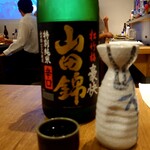
山盛りのピグレット
4.00
I ordered the rare tuna cutlet, dashi-maki tamago (Japanese rolled omelette), and seafood croquettes (that day, we had crab cream croquettes and scallop cream croquettes). The system of choosing either sashimi or tempura as an appetizer was just as the reviews said! I chose tempura, while my friend opted for sashimi. I was excited to see what kind of tempura would come out, and to my surprise, it was deep-fried cod milt! This was my first time trying cod milt, and I was nervous but excited to taste it! (Personally, I didn’t find cod milt to be my favorite.) The dishes we ordered were all delicious, and especially the rare tuna cutlet was quite filling, which made me really satisfied! It’s definitely better to eat it while it’s warm! There were many other menu items that caught my interest, so I’d love to go back again! 😊
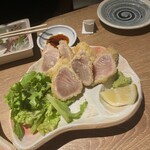
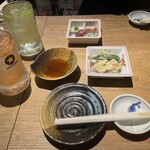
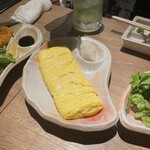
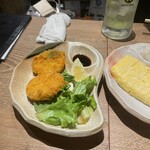
kanokoron
4.00
I could only make a reservation for lunch at 2 PM, and I was wondering why, but it turns out they only serve lunch on weekends. However, since I had made a reservation, they accommodated me even though it was a weekday. I chose the simmered fish set meal, and on that day, it was simmered Takanoha-dai. After waiting for 15 minutes, what arrived was HUGE!!! The tail was sticking out of the curry plate; it was clearly not a single serving for one person. Right? The flavor was sweet, similar to a grilled eel sauce. It was so large, and there were a lot of scales and bones, making it a bit difficult to eat. I ended up taking over 30 minutes to finish. The sauce was sweet, and I got a little tired of it, but I was satisfied with the portion size. The rice was firm, which I liked, and the small side dish served with it looked well-prepared. There was also thick sashimi included. I might have consumed a month's worth of fish in one meal... The price was a bit high at 1500 yen, but given the quality of the meal, it was reasonable. It might be a good idea to check in advance whether they do lunch on weekdays if you plan to reserve.
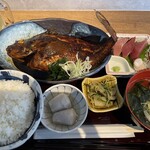
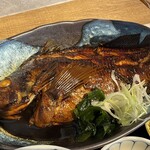
mogyumogyu
4.00
I enjoyed a lunch featuring braised rockfish. The sauce for the braise was rich in flavor and very delicious! You can also get free refills of rice, and the sashimi included three types: bonito, yellowtail (or maybe buri?), and tuna (possibly medium fatty tuna?), with two slices of each. It was quite luxurious. I really appreciate getting all this for 1500 yen. I want to go again!

tokyotokkyo
3.30
On Sunday, I visited Jimbocho for lunch after a regular live performance, without having decided on a specific place to go. I stumbled upon a restaurant that looked delicious, so I decided to go in. I ordered a tempura set meal which included tempura of eggplant, pumpkin, squid, shrimp, and whiting—a delightful mix of seafood and vegetables. The miso soup made with clam broth was also delicious. The restaurant was quite busy on Sunday afternoon, so I can imagine it must be bustling during the weekdays. Thank you for the meal, I will come again!
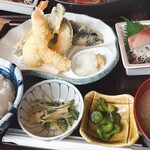
PITO
3.50
This is my second visit. Everything here is truly delicious! I especially recommend the buri shabu. The garnishes are awesome, and it's perfect for hot weather. The sashimi platter even came with sea urchin! There’s a wide variety of sake, and the three-sake tasting set is particularly a great deal. They offer different kinds of sake every time! Thank you for the wonderful meal!

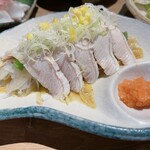
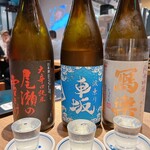
taxee_ogawax1978
3.40
Today, I visited the area around Kasuga for some errands. I learned for the first time that the name "Kasuga" is derived from the famous Kasuga-no-Tsubone. On my way back, I headed south along Hakusan-dori to search for lunch. Passing by what used to be the Tokyo Metropolitan Art High School near Kichijoji, I crossed over Suidobashi Station and quickly found myself in Jimbocho. While wandering around, I discovered this restaurant. By the time I arrived, I was drenched in sweat. It's sad to age, isn't it? I've always been a bit of a heavy sweater since my younger days... I arrived around 1 PM. During lunch hours, the counter was cluttered, so they seated me at a table as a solo diner. There was a group of six, a group of four, and two other solo diners besides myself. Another solo diner arrived while I was ordering. I was tempted by the impressive grilled chicken set that the solo diner next to me was having, but I decided to go with the fish simmered in broth set, as I hadn't been able to eat much lately. After about a 15-minute wait, I suspected the restaurant was run by one cook and one server. If there are many group customers, it's best to be prepared for a bit of a wait. Finally, here comes my meal. I had expected a traditional Japanese-style dish when I ordered the simmered fish set, but to my surprise, it was served in a somewhat Western-style soup reminiscent of aquapazza, with a hint of spice that was quite stylish. Although it caught me off guard, it was unexpectedly delicious. It had a fleeting curry-like flavor that vanished in an instant. Despite being Western-style, it would be great with some nam pla and sprinkled cilantro. The sashimi didn't look too appealing, but it tasted fine. There was a system where I could choose between Kikkoman's dark soy sauce or Fundokin's sweet soy sauce for the sashimi. More and more restaurants are offering Kyushu-style soy sauce for sashimi these days. Overall, I think this is a great restaurant with generous portions. Rather than thinking of coming back for drinks at night, I’d like to keep it as a lunch option in the future.
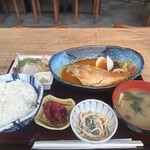
myumini
3.50
Delicious, you can smoke, and they're open late—it's the best! Great sake and fish. #UMIGAM I-050-5590-8387, 1-10-1 Kanda Jinbocho, Chiyoda-ku, Tokyo. https://tabelog.com/tokyo/A1310/A131003/13290549/ #Tokyo #TokyoGourmet #Gourmet #ConnectWithFoodLovers #Lunch #Delicious #Tasty #Yummy #Foodie #InstaFood #FoodStagram #DeliciousFood #JapaneseFood #Japan



トントンマン
3.60
The 2024 issue has been highlighted mainly due to the abolition of the grace period for the upper limit of overtime work, leading to constraints in securing labor. This is particularly concerning in industries like transportation, where it is linked to the workforce shortage in related sectors and is expected to have a significant impact on people's daily lives. The labor shortage in Japan's job market arises directly from population decline and rising job vacancy rates, representing a structural problem. However, the severity of this issue varies by industry and type of employment. In the case of full-time employees, it is particularly pronounced in sectors like information services, maintenance, security, and construction. On the other hand, in the non-regular employment sphere, industries such as restaurants, inns, hotels, human resource dispatch, and food retail face a particularly serious labor shortage, indicating that industries featured on platforms like Tabelog are not unrelated to this issue.
Recently, during my explorations of eateries, I've encountered instances of temporary and full closures due to labor shortages, which has made me feel this issue very closely. For example, in the Jimbocho area during my lunch activities, I attempted to visit a restaurant called "Furatto Hinata" but was turned away twice. On the same day, I had a similar experience at "Gyunabe, Hiresukiyaki, and Seafood Restaurant Jimbocho Azuki," which is also a member of Tabelog. Upon checking the restaurant's website, I saw no signs of problems, but when I arrived, I found a notice on the door stating, "Due to labor shortages, we will be temporarily closed during the following period." Strangely enough, the closure notice referred to dates beyond my visit, indicating a severe situation.
Having no choice, I used the Tabelog app to search for nearby restaurants and discovered another eatery along Yasukuni Street. This restaurant is located about 50 meters from the A5 exit of the subway, just east of the Jimbocho intersection. Previously, in this location, there was a chicken restaurant called "Hanaage Jimbocho," which I had visited for lunch and reviewed, but it seems that did not last long. After a period of vacancy for restaurant operations, this new establishment opened in November 2023. The parent company is S.K. Corporation, established in August 2005 and based in Kachidoki, Chuo-ku. There is a similarly named restaurant company in Ginza (specifically, "S.K. Corporation" with a middle dot in a different position), which owns an 8-story building on the Ginza Corridor and operates eight restaurants on an 80-tsubo floor, but they are entirely separate entities. The S.K. Corporation I visited operates four establishments, including this one, along with three izakayas in the Jimbocho and Ogawamachi area: Kurikami-bo, Masuya Jimbocho, and Nikumotsuya Jinbo.
Interestingly, it seems this company initially started as a small chain operating four izakayas, including the earlier mentioned "Masuya Jimbocho," but it is likely that they were transitioning ownership as opening four new establishments at once seems unusual. The evidence may not be conclusive, but it's noteworthy that they closed three of the four restaurants in the following year after their founding. The one that survived is "Masuya Jimbocho." During that time, it appears there were significant management shake-ups, including a change in representatives (some sources even mention a bankruptcy), but now Masuya is reported to be in the black.
On the day I visited, there was heavy rain in the morning but it was forecasted to clear up by early afternoon, so I intentionally decided on a later lunch time. After having been turned away earlier, I arrived at the restaurant around 12:40 PM. The interior is relatively modern for an izakaya, albeit somewhat sterile-looking. The seating capacity is 36, featuring four counter seats (which weren't being used during lunchtime) and six tables for four plus one table for eight. There were three groups of four people sitting at tables when I arrived. I chose to sit at the available eight-person table.
The lunch menu was simple, consisting of only four items. However, the prices range from 1,300 to 1,500 yen, which is on the higher side compared to the average lunch in this area. The four options included tempura set for 1,500 yen, saikyo-grilled chicken set for 1,300 yen, along with a daily grilled fish and simmered fish set, the details of which were displayed on a wall inside. That day's grilled fish was houbou (a type of flatfish) and the simmered fish was buri daikon (yellowtail and radish). I opted for the grilled fish set for 1,500 yen, as houbou is not commonly featured in regular izakaya lunches.
After about two minutes, I was served an ice-cold brown rice green tea in a glass, which was flavorful and quite pleasant. After waiting another five minutes, my grilled fish set arrived. The main dish was the houbou, served with an assortment of sashimi, two small side dishes, and miso soup, making for an appealing presentation. The houbou was enjoyed with grated daikon and appeared to have been par-cooked before being grilled again, which I noted was a downside. However, despite its somewhat unappealing appearance, the fish was delicate and had a mild flavor. Although it was overcooked, leading to a slightly dry texture, the taste was good, and there was an ample amount of fish meat after carefully deboning it.
The sashimi assortment included buri, salmon, and octopus, which might be common but was served in thick slices of acceptable quality. The side dishes featured what appeared to be simmered buri milt and a pickled mountain vegetable, demonstrating attention to quality, while the miso soup contained cabbage, wakame, and fish bones, offering a marked improvement compared to typical izakaya lunches. Although my expectations were not particularly high for a chain izakaya, I sensed an intention to provide a higher-quality lunch amid the usual fare, and I believe this strategy is not misguided. There were areas for improvement regarding the cooking of the fish, but overall, the cost-performance ratio was not bad.
However, despite my later arrival for lunch, the restaurant was somewhat empty, suggesting that business might not be thriving. The restaurant seems to be facing challenges as it continues to experiment. However, given that they appear to be listening to customer needs, I sincerely hope that they can endure and succeed in the long run.



◯kazu◯
3.20
I visited the restaurant because a member of our group wanted to eat fish heads. We ordered tuna and yellowtail heads. Personally, I think the grilled yellowtail head is the best ^ ^ It pairs perfectly with a highball. For the starter, we had a choice between sashimi and tempura, and we chose sashimi. Although this restaurant doesn't have very high ratings, I recommend it if you're looking to order fish, as they do offer fish heads.
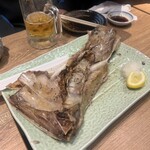
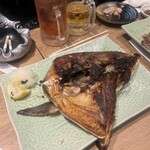
Email Login